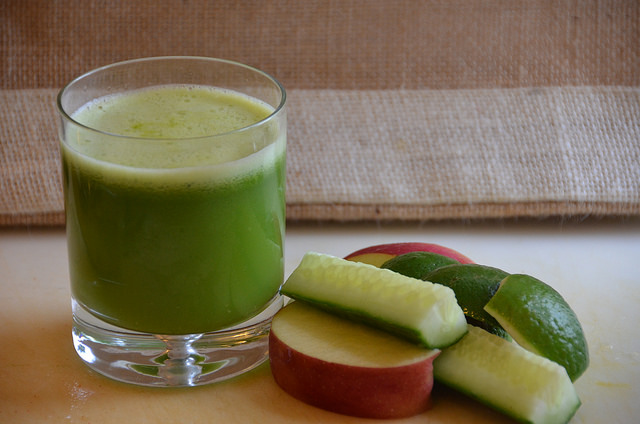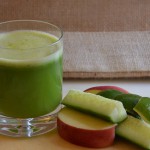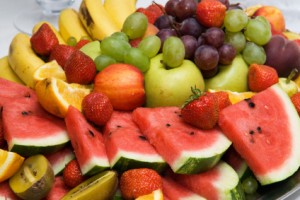
by Kristin Jackson | Mar 13, 2015

Bertholf. (N.D.) Juicing from http://goo.gl/Neu02U
Don’t fool yourself into thinking that drinking 100% fruit juice is the same as eating the whole fruit. Researchers from the Harvard School of Public Health found two key things that may have you re-thinking your breakfast drink:
- In many cases, fruit juice contains as much sugar as soft drinks, although the sugar in fruit juice is naturally occurring.
- Despite the calories in fruit juice, people who drink juice don’t feel as full as if they ate the fruit, so they end up consuming more calories.
When it comes to your children, over-consumption of fruit juice or consuming greater than 12 ounces a day was found to be associated with short stature and obesity. In 2006, 10% of all annual medical spending went to treating obesity-related diseases. When it comes to children specifically, research estimates the average total health care expenditures for a child treated for obesity is nearly three times higher than the average health care cost for all other children.
At this point, you probably are asking, “If juice is out, then what should I do?” UF/IFAS Extension has a solution for you. Try remixing your current plate. Instead of going for the orange juice, grab an orange. Substitute your fruit juice for its whole fruit counterparts. If you decide to make the swap, you will find yourself in need of a drink; try water or milk. For more resources on building a healthy plate, visit:
ChooseMyPlate.gov
Healthy Eating: Smart Snacking
Choose MyPlate: Drink Water Instead of Sugary Drinks
References:
Dennison, B., Rockwell, H. and Baker, S. Excess fruit juice consumption by preschool-aged children is associated with short stature and obesity. Pediatrics 100(4):733, 1997
Department of Nutrition at Harvard School of Public Health. Fact Sheet: Sugary Drink Supersizing and the Obesity Epidemic. Nutrition Source, 2012
Finkelstein EA, Trogdon JG, Cohen JW, Dietz W. Annual Medical Spending Attributable to Obesity: Payer- and Service-specific Estimates. Health Affairs, 28(5): w822-831, 2009.
Marder W and Chang S. Childhood Obesity: Costs, Treatment Patterns, Disparities in Care, and Prevalent Medical Conditions. Thomson Medstat Research Brief, 2006
by Angela Hinkle | May 28, 2013

Fruit – sweet, refreshing, and good for you!
As the days get warmer, bring on the cool refreshment of fruit. Now is the time to delight in fruit’s tasty, healthy goodness.
Reduce Risk and Protect
A healthy diet that is rich in fruits may reduce risk for heart disease, type 2 diabetes, and obesity, and may protect against certain types of cancers.
Healthy Nutrients
Nature brings most fruit to us low in fat, sodium, and calories, and always with zero cholesterol. Fruits are a great source of many essential nutrients and most of us don’t get enough. These include:
- Dietary fiber – helps to reduce blood cholesterol levels, is important for maintaining proper bowel function, helps reduce constipation, and provides a feeling of fullness without too many calories.
- Potassium – helps to maintain healthy blood pressure.
- Vitamin C – important for repairing all body tissues, healing cuts and wounds, and keeping teeth and gums healthy.
- Folate (folic acid) – helps the body form red blood cells and reduces the risk of neural tube defects during fetal development.
The USDA MyPlate recommends making half your plate fruits and vegetables. http://www.choosemyplate.gov
How Can You and Your Family Eat More Fruit?
- For snacks, wash whatever fruits you have on hand and place them in a big attractive bowl or basket on your table or desk. When you go by, you can grab one and start munching on it.
- Make fruit more fun and interesting by cutting it up and making it into a colorful fruit salad.
- Add fresh, frozen, or canned fruit to a smoothie or shake. Add fruit to drinks like tea and lemonade. Add some fruit to your water for a little kick of taste.
- Make a habit of using fruit as a plate garnish for breakfast, lunch, and dinner.
- Add a variety of fruit chunks to bamboo skewers or craft sticks for kabobs.
- Fruit added to yogurt provides more color, flavor, and nutrition.
- Since dried fruits last a long time, you can store a package in your car, desk, or even your pockets for a quick pick-me-up.
Sweet, refreshing, good for you fruit – now is the time to savor and enjoy.
For more information, contact your UF/IFAS county extension office.



